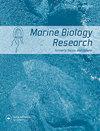红树林“uçá”-螃蟹种群监测进展:减少体型方差以更好地评估种群结构和提取潜力
IF 1.2
4区 生物学
Q4 ECOLOGY
引用次数: 0
摘要
摘要以目标物种为重点的监测是更好地了解生物多样性的重要工具。刺桐的密度、大小、提取潜力和种群结构反映了红树林生态系统的保护。巴西联邦生物多样性保护研究所(ICMBio)制定了一项协议,使用不依赖于捕获物种个体的间接方法来标准化和估计这些参数。在该方案中,使用模型将螃蟹通道的直径(DG)测量值调整为最大甲壳宽度(LC)。由于这种关系(LC与DG)可能因地理位置而异,本研究在巴西三个红树林地区(北部、东北部和东南部地区)进行了评估。这种关系的线性模型在性别之间进行了比较,并作为一个单一模型应用,将这些巴西地区视为一个固定因素,并分别应用于每个地区的三个独立模型中。方程在性别之间没有显著差异,可以表示为每个地方一个。然而,不包括红树林作为固定因子的更简单的线性模型可以用于表示整个纬度梯度,从而促进估计误差的均匀性,因为它涵盖了Ucides cordatus螃蟹的整个体型(LC)变化。亮点通过使用间接方法测量洞穴,可以成功地估计苹果树的体型和种群结构。间接方法有利于持续监测,避免在特定红树林区域捕获造成更高的影响。区域模型可能更准确,但表示整个纬度梯度的单一且更简单的模型可以促进估计误差的同质性,并且更易于管理。本文章由计算机程序翻译,如有差异,请以英文原文为准。
Advances in population monitoring of the mangrove ‘uçá’-crab (Ucides cordatus): reduction of body size variance for better evaluation of population structure and extractive potential
ABSTRACT Monitoring focusing on target species is an important tool to better understand biodiversity. The density, size, extractive potential and population structure of Ucides cordatus reflects the conservation of the mangrove ecosystem. The Federal Brazilian Institution of Biodiversity Conservation (ICMBio) defined a protocol to standardize and estimate these parameters using an indirect method that does not depend on the capture of individuals of a species. In this protocol are used models to adjust diameter of crabs' gallery (DG) measures into largest carapace width (LC). Because this relationship (LC vs. DG) can differ according to geographic positions, the present study assessed it in three Brazilian mangrove areas (north, north-east, and south-east regions). Linear models of this relationship were compared between sexes, and also applied as a single model considering these Brazilian localities as a fixed factor and in three independent models for each locality separately. Equations did not differ significantly between sex and could be represented as one to each locality. However, a simpler linear model not including mangroves as fixed factors can be used to represent the entire latitudinal gradient, promoting a homogeneity of the estimation error, due to cover the entire body size (LC) variation of the Ucides cordatus crab. HIGHLIGHTS Body size and population structure of Ucides cordatus can be successfully estimated by measurements of the burrows, using an indirect method. Indirect method is advantageous in continuous monitoring, avoiding the higher impact promoted by capture in a specific mangrove area. Regional models can be more accurate, but a single and simpler model representing the entire latitudinal gradient can promote homogeneity of the estimation error and is more manageable.
求助全文
通过发布文献求助,成功后即可免费获取论文全文。
去求助
来源期刊

Marine Biology Research
生物-海洋与淡水生物学
CiteScore
2.10
自引率
0.00%
发文量
55
审稿时长
6-12 weeks
期刊介绍:
Marine Biology Research (MBRJ) provides a worldwide forum for key information, ideas and discussion on all areas of marine biology and biological oceanography. Founded in 2005 as a merger of two Scandinavian journals, Sarsia and Ophelia, MBRJ is based today at the Institute of Marine Research, Bergen, Norway. The Journal’s scope encompasses basic and applied research from all oceans and marine habitats and on all marine organisms, the main criterium for acceptance being quality.
 求助内容:
求助内容: 应助结果提醒方式:
应助结果提醒方式:


